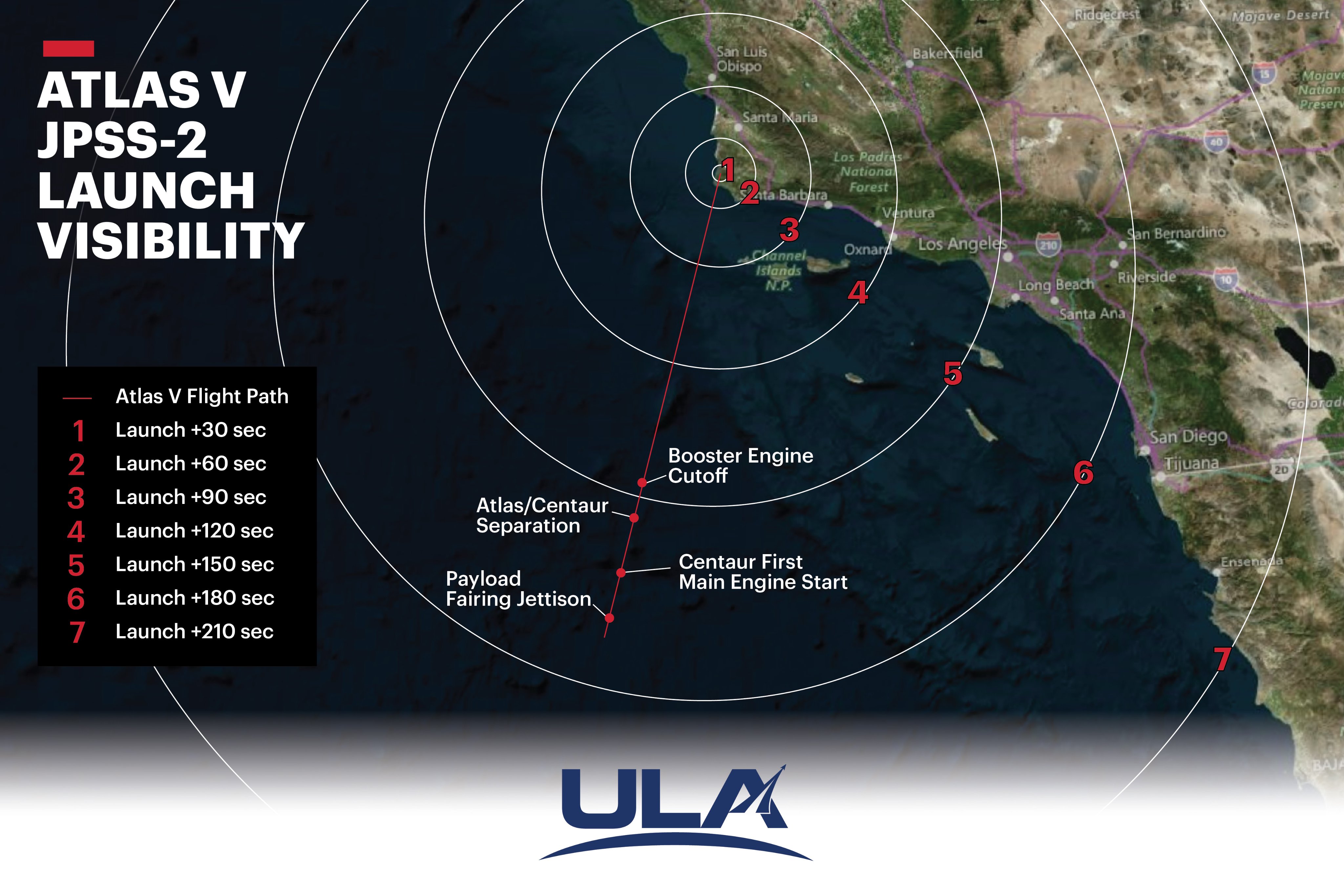Watch Atlas V rocket launch powerful JPSS-2 weather satellite early Thursday
Liftoff is scheduled for 4:25 a.m. ET on Thursday (Nov. 10).
NASA and the U.S. National Oceanic and Atmospheric Administration (NOAA) are set to launch a new weather and climate monitoring satellite early Thursday (Nov. 10), and you can watch the action live.
The Joint Polar Satellite System-2 (JPSS-2) spacecraft is scheduled to lift off Thursday from Vandenberg Space Force Base in California at 4:25 a.m. EST (0925 GMT; 1:25 a.m. local California time) atop a United Launch Alliance Atlas V rocket. Watch it here at Space.com, courtesy of NASA, or directly via the space agency; coverage will begin at 3:45 a.m. EST (0845 GMT).
The launch may be visible from broad swaths of the California coast, weather permitting. So if you live in the Golden State and are a night owl (or a very early riser), you might want to go outside and look up at the appointed time.
Related: Powerful new Earth-monitoring satellite JPSS-2 to study weather's 'butterfly effect'

JPSS-2 will be operated by NOAA once it reaches its final destination, a path in low Earth orbit that takes it over the planet's poles. Two other JPSS spacecraft already study Earth from that orbit, circling the globe 14 times every 24 hours and fully surveying the planet twice a day.
JPSS-2's instrument suite will collect data about Earth's surface temperatures, cloud densities and aerosols in order to improve weekly weather forecasts and severe weather predictions, among other uses.
In a prelaunch press briefing held on Tuesday (Nov. 9), Jordan Gerth, meteorologist and satellite scientist for NOAA's National Weather Service, explained that JPSS-2's contributions, while global in scope, also have very localized applications.
Get the Space.com Newsletter
Breaking space news, the latest updates on rocket launches, skywatching events and more!
"The observations are global. The predictions are local," Gerth said. "With JPSS, the quality of local three- to seven-day weather forecasts is outstanding."
In addition to better helping you decide whether or not to grab your umbrella before heading out the door, JPSS-2 will also monitor sea ice, algae blooms, wildfires, ocean surface temperatures and temperatures in Earth's atmosphere to contribute data to an archive of climate research for global weather models.
JPSS-2 will launch atop an Atlas V 401, a bare-minimum variation of the workhorse rocket with a 13-foot-wide (4 meters) payload fairing, no solid rocket boosters and a single RL10-1 engine powering the vehicle's Centaur upper stage. This Atlas V also happens to be the last to ever launch from Vandenberg Space Force Base.
"We're launching the last Atlas V from the West Coast, enabling ULA to have some huge capability out of here with their Vulcan vehicle," Capt. Zack Zounes, launch weather officer for the U.S. Space Force, said during an Oct. 28 JPSS-2 briefing. (Vulcan is ULA's next-generation rocket, which is scheduled to debut in 2023.)
Tucked underneath JPSS-2 inside the Atlas V's fairing is another payload, NASA's Low-Earth Orbit Flight Test of an Inflatable Decelerator (LOFTID). LOFTID is a technology demonstration of an expandable heat shield designed to protect heavy payloads during atmospheric entries.
Punching a spacecraft through planetary atmospheres is one of the most difficult feats to accomplish in spaceflight, and heat shields are often among a spacecraft's heaviest components. Inflatable heat shields have the potential to greatly increase the maximum payload mass NASA can land on Mars and other planets, agency officials have said. LOFTID's flight will provide crucial data about how such hardware performs in the harsh reentry environment.
Joe Del Corso, LOFTID project manager at NASA's Langley Research Center, explained LOFTID's reentry procedure.
"After delivering JPSS-2 to Earth orbit, the Centaur second stage will deorbit the LOFTID vehicle, turn the LOFTID vehicle on, and then LOFTID will then inflate the aeroshell and be released by the Centaur," Del Corso said during Tuesday's media call.
Traveling nearly 29 times the speed of sound, LOFTID's reentry will be recorded by a host of onboard sensors, whose data collection will include "temperatures across the aeroshell, pressures and heat flux on the nose cap, as well as 360-degree video on six video cameras, and IR data from 12 infrared cameras," Del Corso explained. LOFTID will eventually splash down softly under parachutes, and teams hope to recover its payloads intact.
The JPSS-2 launch was originally scheduled for Nov. 1 but was delayed to allow launch teams to replace a battery on the Centaur.
Follow us on Twitter @Spacedotcom and on Facebook.
Join our Space Forums to keep talking space on the latest missions, night sky and more! And if you have a news tip, correction or comment, let us know at: community@space.com.

Josh Dinner is the Staff Writer for Spaceflight at Space.com. He is a writer and photographer with a passion for science and space exploration, and has been working the space beat since 2016. Josh has covered the evolution of NASA's commercial spaceflight partnerships and crewed missions from the Space Coast, as well as NASA science missions and more. He also enjoys building 1:144-scale model rockets and human-flown spacecraft. Find some of Josh's launch photography on Instagram and his website, and follow him on X, where he mostly posts in haiku.









